Polaris RZR S 800, RZR 800, RZR 4 800 User Manual
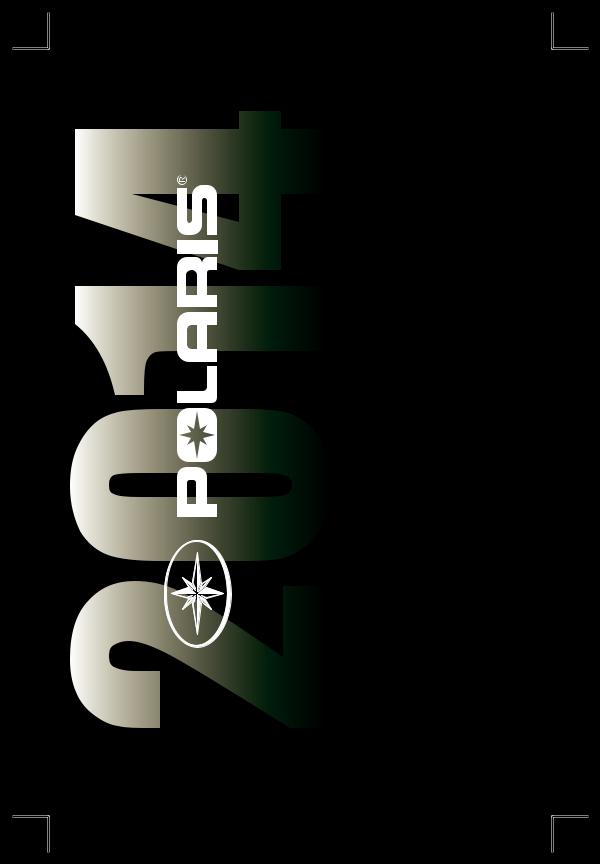
PMS 419
RZR® 800 RZR® S 800
RZR® 4 800
Owner's Manual
for Maintenance and Safety

 WARNING
WARNING
Read, understand, and follow all of the instructions and safety precautions in this manual and on all product labels.
Failure to follow the safety precautions could result in serious injury or death.
 WARNING
WARNING
The engine exhaust from this product contains chemicals known to the State of California to cause cancer, birth defects or other reproductive harm.

WELCOME
Thank you for purchasing a POLARIS vehicle, and welcome to our world-wide family of POLARIS enthusiasts. Be sure to visit us online at www.polaris.com for the latest news, new product introductions, upcoming events, career opportunities and more.
Here at POLARIS we proudly produce an exciting line of utility and recreational products.
•Snowmobiles
•All-terrain vehicles (ATVs)
•Low emission vehicles (LEVs)
•RANGER® utility vehicles
•RZR® sport vehicles
•VICTORY® motorcycles
•GEM® electric vehicles
We believe POLARIS sets a standard of excellence for all utility and recreational vehicles manufactured in the world today. Many years of experience have gone into the engineering, design, and development of your POLARIS vehicle, making it the finest machine we’ve ever produced.
For safe and enjoyable operation of your vehicle, be sure to follow the instructions and recommendations in this owner’s manual. Review the safety DVD that came with your vehicle. Polaris also recommends that all drivers take the ROHVA safety e-course and a ROHVA hands-on safety training course (www.rohva.org).
Your manual contains instructions for minor maintenance, but information about major repairs is outlined in the POLARIS Service Manual and should be performed only by a factory certified Master Service Dealer® (MSD) Technician.
Your POLARIS dealer knows your vehicle best and is interested in your total satisfaction. Be sure to return to your dealership for all of your service needs during, and after, the warranty period.
1
POLARIS® and RZR® are registered trademarks of POLARIS Industries Inc.
Copyright 2012 POLARIS Sales Inc. All information contained within this publication is based on the latest product information at the time of publication. Due to constant improvements in the design and quality of production components, some minor discrepancies may result between the actual vehicle and the information presented in this publication. Depictions and/or procedures in this publication are intended for reference use only. No liability can be accepted for omissions or inaccuracies. Any reprinting or reuse of the depictions and/or procedures contained within, whether whole or in part, is expressly prohibited.
The original instructions for this vehicle are in English. Other languages are provided as translations of the original instructions.
Printed in U.S.A.
2014 RZR 800 / RZR S 800 / RZR 4 800 Owner’s Manual P/N 9924707
2
TABLE OF CONTENTS
Introduction . . . . . . . . . . . . . . . . . . . . . . . . . . . . 4
Safety . . . . . . . . . . . . . . . . . . . . . . . . . . . . . . . . . 7
Features and Controls . . . . . . . . . . . . . . . . . . . 25
Operation . . . . . . . . . . . . . . . . . . . . . . . . . . . . . 46
Winch Guide . . . . . . . . . . . . . . . . . . . . . . . . . . . 65
Emission Control Systems . . . . . . . . . . . . . . . 76
Maintenance . . . . . . . . . . . . . . . . . . . . . . . . . . . 77
Specifications. . . . . . . . . . . . . . . . . . . . . . . . . 132
POLARIS Products. . . . . . . . . . . . . . . . . . . . . 136
Troubleshooting . . . . . . . . . . . . . . . . . . . . . . . 137
Warranty . . . . . . . . . . . . . . . . . . . . . . . . . . . . . 141
Maintenance Log . . . . . . . . . . . . . . . . . . . . . . 148
Index . . . . . . . . . . . . . . . . . . . . . . . . . . . . . . . . 150
3

INTRODUCTION
The RZR is an off-road vehicle. Familiarize yourself with all laws and regulations concerning the operation of this vehicle in your area.
The following signal words and symbols appear throughout this manual and on your vehicle. Your safety is involved when these words and symbols are used. Become familiar with their meanings before reading the manual.
The safety alert symbol indicates a potential personal injury hazard.
DANGER
A DANGER indicates a hazardous situation that, if not avoided, will result in death or serious injury.
WARNING
A WARNING indicates a hazardous situation that, if not avoided, could result in death or serious injury.
CAUTION
A CAUTION indicates a hazardous situation that, if not avoided, could result in minor or moderate injury.
NOTICE
A NOTICE indicates a situation that could result in property damage.
The Prohibition Safety Sign indicates an action NOT to take in order to avoid a hazard.
The Mandatory Action Sign indicates an action that NEEDS to be taken to avoid a hazard.
4

INTRODUCTION
 WARNING
WARNING
Failure to heed the warnings and safety precautions contained in this manual can result in severe injury or death. Your POLARIS vehicle is not a toy and can be hazardous to operate. This vehicle handles differently than cars, trucks or other off-road vehicles. A collision or rollover can occur quickly, even during routine maneuvers like turning, or driving on hills or over obstacles, if you fail to take proper precautions.
•Read this owner’s manual and review the safety DVD that came with your vehicle. A free extra copy of the DVD can be obtained by contacting your local POLARIS dealer. Understand all safety warnings, precautions and operating procedures before operating the vehicle. Keep this manual with the vehicle.
•This vehicle is an ADULT VEHICLE ONLY. You MUST be at least age 16 and have a valid driver’s license to operate this vehicle.
•No person under the age of 12 may ride as a passenger in this vehicle. All riders must be able to sit with backs against the seat, both feet flat on the floor and both hands on the steering wheel (if driving) or on a passenger hand hold.
•Always use the cab nets (or doors) while riding in this vehicle. Always keep hands, feet and all other body parts inside the vehicle at all times.
•Always wear a helmet, eye protection, gloves, long-sleeve shirt, long pants and over-the-ankle boots.
•Never use this vehicle with drugs or alcohol, as these conditions impair judgment and reduce operator reaction time.
•Complete the New Operator Driving Procedures outlined on pages 52-53. Never allow a guest to operate this vehicle until the guest has completed the New Operator Driving Procedures.
European Vibration and Noise
The driver-perceived noise and hand/arm and whole body vibration levels of this machinery is measured per prEN 15997.
The operating conditions of the machinery during testing:
The vehicles were in like-new condition. The environment was controlled as indicated by the test procedure(s).
The uncertainty of vibration exposure measurement is dependent on many factors, including:
•Instrument and calibration uncertainty
•Variations in the machine such as wear of components
•Variation of machine operators such as experience or physique
•Ability of the worker to reproduce typical work during measurements
•Environmental factors such as ambient noise or temperature
5

INTRODUCTION
Vehicle Identification Numbers
Record your vehicle's identification numbers and key number in the spaces provided. Remove the spare key and store it in a safe place. An ignition key can be duplicated only by ordering a POLARIS key blank (using your key number) and mating it with one of your existing keys. The ignition switch must be replaced if all keys are lost.
Key
Number
#### 
Vehicle Identification Number Stamp |
Engine Serial Number |
|
|
(Left Rear Fender Area Near Air Box) |
|
Manufacturing Data Label
(Right Front Fender Area)
Vehicle Model Number: ___________________________________________________
Vehicle Identification Number: ______________________________________________
Engine Serial Number: ___________________________________________________
Key Number ____________________________________________________________
6
SAFETY
Safety Training
Safety training is a top priority for POLARIS. POLARIS strongly encourages you and any family members who will be riding this vehicle to take a training course.
ROHVA (Recreational Off-Highway Vehicle Association) provides both an online safety e-course and a hands-on safety course. To access this valuable training, visit www.rohva.org.
Your POLARIS vehicle is considered an off-road vehicle. Familiarize yourself with all laws and regulations concerning the operation of this vehicle in your area.
We strongly advise you to strictly follow the recommended maintenance program outlined in your owner's manual. This preventive maintenance program is designed to ensure that all critical components on your vehicle are thoroughly inspected at specific intervals.
For more information about recreational off-road vehicle safety in the United States, visit www.rohva.org or call POLARIS at 1-800- 342-3764.
7
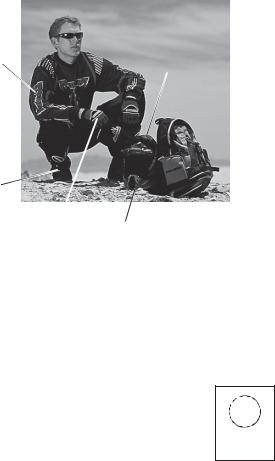
SAFETY
Safe Riding Gear
The driver and all passengers must wear helmet, eye protection, gloves, long-sleeve shirt, long pants, over-the-ankle boots and seat belt at all times. Protective gear reduces the chance of injury.
Long |
Eye |
Sleeves |
Protection |
Long
Pants 
Over-the-Ankle
Boots
Gloves Helmet
Helmet
Wearing a helmet can prevent a severe head injury. Whenever riding this POLARIS vehicle, always wear a helmet that meets or exceeds established safety standards.
Approved helmets in the USA and Canada bear a U.S. Department of Transportation (DOT) label.
Approved helmets in Europe, Asia and Oceania bear the ECE 22.05 label. The ECE mark consists of a circle surrounding the letter E, followed by the distinguishing number of the country which has granted approval. The approval number and serial number will also be displayed on the label.
E4
051039
0006.31
8
SAFETY
Safe Riding Gear
Eye Protection
Do not depend on eyeglasses or sunglasses for eye protection. Whenever riding this POLARIS vehicle, always wear shatterproof goggles or use a shatterproof helmet face shield. POLARIS recommends wearing approved Personal Protective Equipment (PPE) bearing markings such as VESC 8, V-8, Z87.1, or CE. Make sure protective eye wear is kept clean.
Gloves
Wear gloves for comfort and for protection from sun, cold weather and other elements.
Boots
Wear sturdy over-the-ankle boots for support and protection. Never ride a POLARIS vehicle with bare feet or sandals.
Clothing
Wear long sleeves and long pants to protect arms and legs.
Rider Comfort
Under certain operating conditions, heat generated by the engine and exhaust system can elevate temperatures in the driver and passenger cab area. The condition occurs most frequently when a vehicle is being operated in high ambient temperatures at low speeds and/or high load conditions for an extended period of time. The use of certain windshield, roof and/or cab systems may contribute to this condition by restricting airflow. Any discomfort due to heat buildup in this area can be minimized by wearing proper riding apparel and by varying speeds to increase airflow.
9
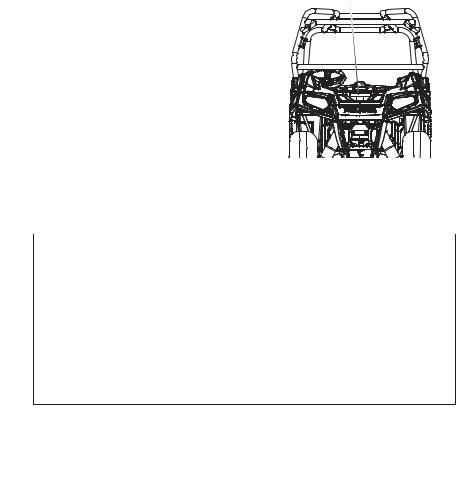
SAFETY
Safety Labels and Locations
Warning labels have been placed on the vehicle for your protection. Read and follow the instructions of the labels on the vehicle carefully. If any of the labels depicted in this manual differ from the labels on your vehicle, always read and follow the instructions of the labels on the vehicle.
If an informational or graphic label becomes illegible or comes off, contact your POLARIS dealer to purchase a replacement. Replacement safety labels are provided by POLARIS at no charge. The part number is printed on the label.
Load/Passenger/Tire Pressure Warning
WARNING
•Passengers can be thrown off. This can cause serious injury or death.
•Never carry passengers in cargo box.
Load/Passenger/Tire Pressure
Warning
WARNING
IMPROPER TIRE PRESSURE OR OVERLOADING CAN CAUSE LOSS OF CONTROL RESULTING IN SERIOUS INJURY OR DEATH.
• Reduce speed and allow greater distance for braking when carrying cargo.
• Overloading or carrying tall, off-center, or unsecured loads will increase your
risk of losing control. Loads should be centered and carried as low as possible in box.
•For stability on rough or hilly terrain, reduce speed and cargo.
•Be careful if load extends over the side of the box.
|
RZR |
RZR S |
RZR 4 |
MAXIMUM CARGO BOX LOAD |
300 lbs. |
300 lbs. |
300 lbs. |
|
(136 kg) |
(136 kg) |
(136 kg) |
TIRE PRESSURE IN PSI (KPa) |
1 RIDER |
FRONT 10 (69) |
FRONT 12 (83) |
|
FRONT 8 (55) |
||
|
REAR 10 (69) |
REAR 10 (69) |
REAR 14 (97) |
|
2 RIDERS |
|
|
|
FRONT 10 (69) |
|
|
|
REAR 12 (83) |
|
|
MAXIMUM WEIGHT CAPACITY |
740 lbs. |
740 lbs. |
900 lbs. |
INCLUDES WEIGHT OF OPERATOR, |
|||
PASSENGER, CARGO AND |
(336 kg) |
(336 kg) |
(408 kg) |
ACCESSORIES |
|
|
|
Read Operation and Maintenance Manual for more detailed loading information.
10
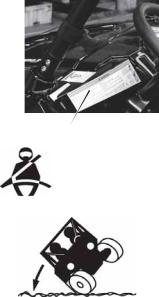
SAFETY
Safety Labels and Locations
Seat Belt/Drive Responsibly Warning
WARNING
Improper vehicle use can result in SEVERE INJURY or DEATH
Be Prepared
•Fasten seat belts.
•Wear an approved helmet and protective gear.
•ALWAYS use cab nets and/or doors.
•Each rider must be able to sit with back against seat, feet flat on the floor, and hands on steering wheel or hand holds. Stay completely inside the vehicle.
Drive Responsibly
Avoid loss of control and rollovers:
•Avoid abrupt maneuvers, sideways sliding, skidding or fishtailing, and never do donuts.
•Slow down before entering a turn.
•Avoid hard acceleration when turning, even from a stop.
•Plan for hills, rough terrain, ruts and other changes in traction and terrain.
•Avoid paved surfaces.
•Avoid sidehilling (riding across slopes).
Be Sure Riders Pay Attention and Plan Ahead
Seat Belt/Drive
Responsibly
Warning
Rollovers have caused severe injuries and death, even on flat, open areas.
If you think or feel the vehicle may tip or roll, reduce your risk of injury:
•Keep a firm grip on the steering wheel or hand holds and brace yourself.
•Do not put any part of your body outside of the vehicle for any reason.
LOCATE AND READ OWNER’S MANUAL. FOLLOW ALL INSTRUCTIONS AND WARNINGS. ALWAYS REVIEW SAFETY VIDEO AND TAKE ROHVA TRAINING (rohva.org).
7179988
11
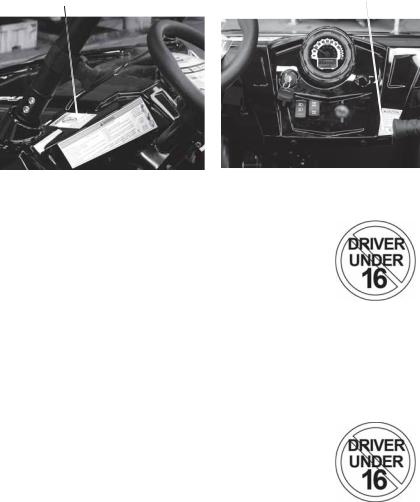
SAFETY
Safety Labels and Locations
Proper Use |
Shift Caution |
Warning |
Proper Use Warning (RZR)
WARNING
Require Proper Use of Your Vehicle
Do your part to prevent injuries:
•Do not allow careless or reckless driving.
•Make sure operators are 16 or older with a valid driver’s license.
•Do not let people drive or ride after using alcohol or drugs.
•Do not allow operation on public roads (unless designated
for off-highway vehicle access) - collisions with cars and trucks can occur.
•Do not exceed seating capacity: 2 occupants.
7179978
Proper Use Warning (RZR 4)
WARNING
Require Proper Use of Your Vehicle
Do your part to prevent injuries:
•Do not allow careless or reckless driving.
•Make sure operators are 16 or older with a valid driver’s license.
•Do not let people drive or ride after using alcohol or drugs.
•Do not allow operation on public roads (unless designated
for off-highway vehicle access) - collisions with cars and trucks can occur.
Do not exceed seating capacity: 4 occupants.
7179980
12
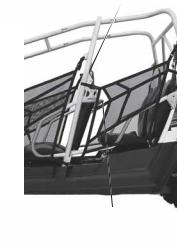
Safety Labels and Locations
Rear Passenger Cab Frame Warning (RZR 4)
WARNING
Do NOT hold onto this bar. Hands and arms could be crushed or seriously injured in event of rollover.
ALWAYS keep hands on passenger hand hold.
7176700
Rear Passenger Hand Hold Warning (RZR 4)
Always use seat belt, helmet and eye protection.
Always use this passenger hand hold and side nets to keep hands and feet in vehicle at all times.
7176701
Shift Caution
CAUTION
SAFETY
Passenger Cab Frame
Warning (both sides)
Passenger Grab Bar
Grab Bar
Warning
To avoid transmission damage, shift only when vehicle is stationary and at idle. When vehicle is stopped, place shift in the parked position.
APPLY BRAKE TO START
7174843
13

SAFETY
Safety Warnings
 WARNING
WARNING
Failure to operate this vehicle properly can result in a collision, loss of control, accident or rollover, which may result in serious injury or death. Heed all safety warnings outlined in this section of the owner’s manual and in the safety DVD provided with your vehicle. See the OPERATION section of the owner’s manual for proper operating procedures.
Operating Without Instruction
Operating this vehicle without proper instruction increases the risk of an accident. The operator must understand how to operate the vehicle properly in different situations and on different types of terrain. Complete the New Operator Driving Procedures outlined on pages 52-53.
All operators must read and understand the owner's manual and all warning and instruction labels before operating the vehicle. Never allow a guest to operate this vehicle until the guest has completed the New Operator Driving Procedures outlined on pages 52-53.
Operator Restrictions/Age Restrictions
This vehicle is an ADULT VEHICLE ONLY. Operation is prohibited for anyone under 16 years of age or anyone without a valid driver’s license.
Never operate with a passenger under the age of 12. All riders must be able to sit with backs against the seat, both feet flat on the floor and both hands on the steering wheel (if driving) or on a passenger hand hold.
Using Alcohol or Drugs
Riding in this vehicle after consuming alcohol or drugs could adversely affect operator judgment, reaction time, balance and perception.
Never consume alcohol or drugs before or while operating or riding in this vehicle.
14

SAFETY
Safety Warnings
Failure to Inspect Before Operating
Failure to inspect and verify that the vehicle is in safe operating condition before operating increases the
risk of an accident.
Always perform the pre-ride inspection before each use of your vehicle to make sure it's in safe operating condition. See page 48.
Always follow the inspection and maintenance procedures and schedules described in this owner’s manual. See page 77.
Protective Apparel
Riding in this vehicle without wearing an approved helmet and protective eyewear increases the risk of a serious injuries in the event of an accident.
Always wear a helmet, eye protection, gloves, long-sleeve shirt, long pants and over-the-ankle boots.
Seat Belts
Riding in this vehicle without wearing the seat belt increases the risk of serious injury in the event of rollover, loss of control, other accident or sudden stop. Seat belts may reduce the severity of injury in these circumstances.
All riders must wear seat belts at all times.
Cab Nets
Riding in this vehicle without using the cab nets (or doors, if equipped) increases the risk of serious injury or death in the event of an accident or rollover. Always use the cab nets (or doors) while riding in this vehicle. Always keep hands and feet inside the vehicle at all times.
Carrying Multiple Passengers (RZR)
Never carry a passenger until you have operated this vehicle for at least two hours and have completed the New Operator Driving Procedures outlined on pages 52-53.
A passenger must always be seated in a passenger seat with seat belt secured. Carrying more than one passenger in a 2-seat vehicle can affect the operator’s ability to steer and operate the controls, which increases the risk of loss of control and accident or rollover. Never carry more than one passenger in a 2-seat vehicle.
15

SAFETY
Safety Warnings
Carrying Multiple Passengers (RZR 4)
Never carry a passenger until you have operated this vehicle for at least two hours and have completed the New Operator Driving Procedures outlined on pages 52-53.
A passenger must always be seated in a passenger seat with seat belt secured.
Never carry more than three passengers in a 4-seat vehicle.
Operating With a Load on the Vehicle
The weight of both cargo and passengers impacts vehicle operation and stability. The weight of both cargo and passengers impacts vehicle operation. For your safety and the safety of others, carefully consider how your vehicle is loaded and how to safely operate the vehicle. Follow the instructions in this manual for loading, tire pressure, gear selection and speed.
•Do not exceed vehicle weight capacities. The vehicle’s maximum weight capacity is listed in the specifications section of this manual and on a label on the vehicle. When more passenger weight is added, cargo weight may need to be reduced accordingly.
•The recommended tire pressures are listed in the specifications section of this manual and on a label on the vehicle.
Always follow these guidelines:
Under ANY of these conditions: |
Do ALL of these steps: |
|
Passenger and/or cargo exceeds half the |
1. |
Slow down. |
maximum weight capacity |
2. |
Verify tire pressure. |
Operating in rough terrain |
3. |
Use extra caution when |
|
|
operating. |
Operating over obstacles |
|
|
|
|
|
|
|
|
Climbing an incline |
|
|
|
|
|
Towing |
|
|
|
|
|
16
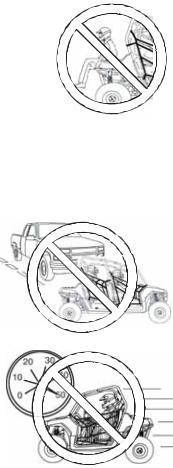
SAFETY
Safety Warnings
Passengers in the Cargo Box
Carrying a passenger in the cargo box could result in a fall from the vehicle or contact with moving components. Never allow a passenger to ride in the cargo box. A passenger must always be seated in the passenger seat with seat belt secured. A passenger must always be seated in a passenger seat with seat belt secured.
Operating on Pavement
This vehicle's tires are designed for off-road use only, not for use on pavement. Operating this vehicle on paved surfaces (including sidewalks, paths, parking lots and driveways) may adversely affect the handling of the vehicle and may increase the risk of loss of control and accident or rollover. Avoid operating the vehicle on pavement. If it's unavoidable, travel slowly, travel short distances and avoid sudden turns or stops.
Operating on Public Roads
Operating this vehicle on public streets, roads or highways could result in a collision with another vehicle. Never operate this vehicle on any public street, road or highway, including dirt and gravel roads (unless designated for off-highway use). In some areas it's unlawful to operate this vehicle on public streets, roads and highways.
Operating at Excessive Speeds
Operating this vehicle at excessive speeds increases the operator's risk of losing control. Always operate at a speed that's appropriate for the terrain, the visibility and operating conditions, your skills and experience and your passengers’ skills and experience.
17
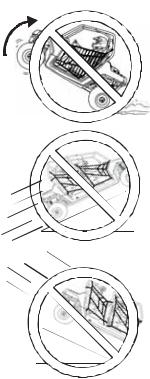
SAFETY
Safety Warnings
Turning Improperly
Turning improperly could cause loss of traction, loss of control, accident or rollover. Always follow proper procedures for turning as described in this owner’s manual.
Avoid sharp turns. Never turn while applying heavy throttle. Never make abrupt steering maneuvers. Practice turning at slow speeds before attempting to turn at faster speeds.
Jumps and Stunts
Exhibition driving increases the risk of an accident or rollover. DO NOT do power slides, “donuts”, jumps or other driving stunts. Avoid exhibition driving.
Improper Hill Climbing
Improper hill climbing could cause loss of control or rollover. Use extreme caution when operating on hills. Always follow proper procedures for hill climbing as described in this owner's manual. See page 56.
Descending Hills Improperly
Improperly descending a hill could cause loss of control or rollover. Always follow proper procedures for traveling down hills as described in this owner’s manual. See page 57.
18
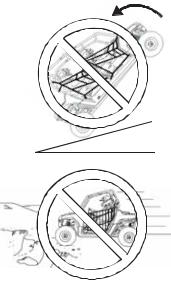
SAFETY
Safety Warnings
Crossing Hillsides
Driving on a sidehill is not recommended. Improper procedure could cause loss of control or rollover. Avoid crossing the side of any hill unless absolutely necessary.
If crossing a hillside is unavoidable, always follow proper procedures as described in this owner's manual. See page 57.
Stalling While Climbing a Hill
Stalling or rolling backwards while climbing a hill could cause a rollover. Maintain a steady speed when climbing a hill.
If you lose all forward speed:
Apply the brakes gradually until the vehicle is fully stopped. Place the transmission in reverse and slowly allow the vehicle to roll straight downhill while applying light brake pressure to control speed.
Operating in Unfamiliar Terrain
Failure to use extra caution when operating on unfamiliar terrain could result in an accident or rollover.
Unfamiliar terrain may contain hidden rocks, bumps, or holes that could cause loss of control or rollover.
Travel slowly and use extra caution when operating on unfamiliar terrain. Always be alert to changing terrain conditions.
19
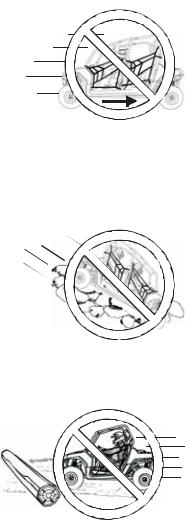
SAFETY
Safety Warnings
Operating Improperly in Reverse
Improperly operating in reverse could result in a collision with an obstacle or person. Always follow proper operating procedures as outlined in this manual. See page 60.
Before shifting into reverse gear, always check for obstacles or people behind the vehicle. When it's safe to proceed, back slowly.
Improper Tire Maintenance
Operating this vehicle with improper tires or with improper or uneven tire pressure could cause loss of control, accident or rollover.
Always use the size and type of tires specified for your vehicle. Always maintain proper tire pressure as described in this owner's manual and on safety labels.
Skidding or Sliding
Failure to use extra caution when operating on excessively rough, slippery or loose terrain
could cause loss of traction, loss of control, accident or rollover. Do not operate on excessively slippery surfaces. Always slow
down and use additional caution when operating on slippery surfaces.
Skidding or sliding due to loss of traction can cause loss of control or rollover (if tires regain traction unexpectedly). Always follow proper procedures for operating on slippery surfaces
as described in this owner's manual. See page 55.
Operating Over Obstacles
Improperly operating over obstacles could cause loss of control or rollover.
Before operating in a new area, check for obstacles. Avoid operating over large obstacles such as large rocks and fallen trees. Always follow the proper procedures outlined in this manual when operating over obstacles. See page 59.
20

SAFETY
Safety Warnings
Operating Through Water
Operating through deep or fast-flowing water can cause loss of traction, loss of control, rollover or accident. Never operate
in fast-flowing water or in water that exceeds the floor level of the vehicle.
Always follow proper procedures for operating in water as described in this owner’s manual. See page 58.
Wet brakes may have reduced stopping
ability. After leaving water, test the brakes. Apply them lightly several times while driving slowly. The friction will help dry out the pads.
Operating on Frozen Bodies of Water
Severe injury or death can result if the vehicle and/or the operator fall through the
ice. Never operate the vehicle on a frozen body of water unless you have first verified that the ice is sufficiently thick to support the
weight and moving force of the vehicle, you and your passengers, and your cargo, together with any other vehicles in your party.
Always check with local authorities and residents to confirm ice conditions and
thickness over your entire route. Vehicle operators assume all risk associated with ice conditions on frozen bodies of water.
Operating a Damaged Vehicle
Operating a damaged vehicle can result in an accident. After any rollover or other accident, have a qualified service dealer inspect the entire machine for possible damage, including (but not limited to) seat belts, rollover protection devices, brakes, throttle and steering systems.
21
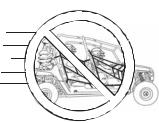
SAFETY
Safety Warnings
Improper Cargo Loading
Overloading the vehicle or carrying/towing cargo improperly may cause changes in stability and handling, which could cause loss of control or an accident.
•Always follow the instructions in this owner’s manual for carrying cargo. See page 62.
• Never exceed the stated load capacity for this vehicle. See page 10.
•Cargo should be properly distributed and securely attached. See page 62.
•Reduce speed when carrying cargo. Allow a greater distance for braking.
Refueling
Gasoline is highly flammable and explosive under certain conditions.
•Always exercise extreme caution whenever handling gasoline.
•Always turn off the engine when refueling.
•Always refuel outdoors or in a well ventilated area free of any source of flame or sparks.
•Always use an approved gasoline container to store fuel and remove the container from the vehicle before filling to avoid fuel ignition due to electrical static discharge.
•Do not smoke or allow open flames or sparks in or near the area where refueling is performed or where gasoline is stored.
•Do not overfill the tank. Do not fill the tank neck.
•If gasoline spills on your skin or clothing, immediately wash it off with soap and water and change clothing.
22
SAFETY
Safety Warnings
Exposure to Exhaust
Engine exhaust fumes are poisonous and can cause loss of consciousness or death in a short time. Never start the engine or let it run in an enclosed area.
Operate this vehicle only outdoors or in well-ventilated areas.
Hot Exhaust Systems
Exhaust system components are very hot during and after use of the vehicle. Hot components can cause burns and fire. Do not touch hot exhaust system components. Always keep combustible materials away from the exhaust system. Use caution when traveling through tall grass, especially dry grass, to avoid debris build-up around the exhaust system.
Unauthorized Use of the Vehicle
Leaving the keys in the ignition can lead to unauthorized use of the vehicle by someone under the age of 16, without a drivers license, or without proper training. This could result in an accident or rollover. Always remove the ignition key when the vehicle is not in use.
23
SAFETY
Safety Warnings
Equipment Modifications
Your POLARIS vehicle is designed to provide safe operation when used as directed. Modifications to your vehicle may negatively impact vehicle stability. Failure of critical machine components may result from operation with any modifications, especially those that increase speed or power. This vehicle may become less stable at speeds higher than those for which it is designed. Loss of control may occur at higher speeds.
Do not install any non-POLARIS-approved accessory or modify the vehicle for the purpose of increasing speed or power. Any modifications or installation of non-POLARIS-approved accessories could create a substantial safety hazard and increase the risk of bodily injury.
The warranty on your POLARIS vehicle will be terminated if any non-POLARIS- approved equipment and/or modifications have been added to the vehicle that increase speed or power.
The addition of certain accessories, including (but not limited to) mowers, blades, tires, sprayers, or large racks, may change the handling characteristics of the vehicle. Use only POLARIS-approved accessories, and familiarize yourself with their function and effect on the vehicle.
FOR MORE INFORMATION ABOUT SAFETY call POLARIS at 1-800-342-3764.
24
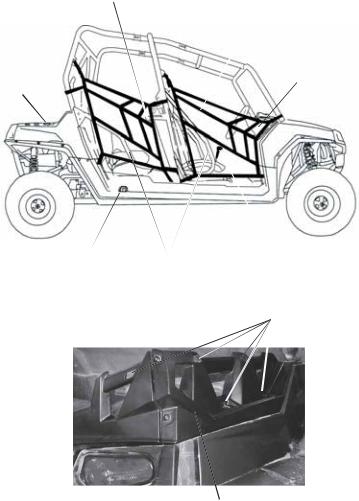
FEATURES AND CONTROLS
Component Locations
|
Rear Passenger |
|
Hand Hold |
|
Cab Nets |
|
Front |
Cargo |
Passenger |
Hand Hold |
|
Box |
|
Shifter
Fuel Tank |
Hip Bars |
|
Cap |
||
|
Tie-Down
Points
Rack Extenders (RZR/RZR EPS only)
25
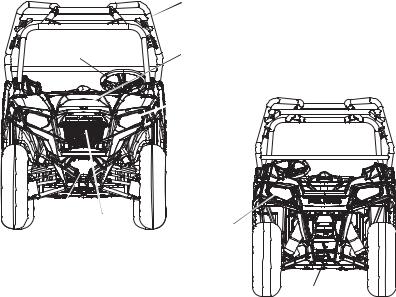
FEATURES AND CONTROLS
Component Locations
|
Cab Frame |
Steering |
Under Hood |
Storage |
|
Wheel |
Compartment |
|
(LE models) |
|
Headlights |
Radiator |
Taillights |
|
Brush Guard |
||
|
Receiver
Hitch
Trailer Receiver Hitch Bracket
This vehicle is equipped with a receiver hitch bracket for a trailer hitch. Trailer towing equipment is not supplied with this vehicle.
To avoid injury and property damage, always heed the warnings and towing capacities outlined on pages 62-64.
26
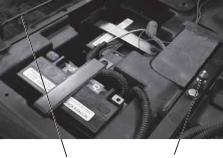
FEATURES AND CONTROLS
Rear Service Panel
The rear service panel is located behind the seats on the frame of the vehicle. Remove the seats to access the service panel. Remove the service panel to access serviceable engine components and clutches.
Radiator Access/Grill Removal
The front grill can be removed to clean debris from the radiator. Push down on the two tabs and pivot the grill outward to remove it.
Seats
Before operating the vehicle, always push down on all seat backs to ensure the latches are secure.
Seat Adjustments
On seats equipped with an adjustment lever, pull upward on the release lever located under the front edge of the seat. Slide the seat forward or rearward to the desired position. Release the lever. The seat will lock into the new position.
For other seat styles, loosen (do not remove) the four screws located on the seat bottom. Slide the seat forward or rearward to the desired position. Tighten the screws to 4 ft. lbs. (5.4 Nm). Do not overtighten.
Seat Removal
1.Pull up on the seat latch lever located under the rear edge of the seat.
2.Tilt the seat forward.
3.Lift the seat upward to remove it from the vehicle.
4.Reverse this procedure to reinstall the seat. Make sure the seat tabs at the front edge of the seat slide under the seat retainer bar.
5.Press down firmly at the rear of the seat to engage the rear latch.
Front Seat |
Seat |
Retainer |
Latch |
27
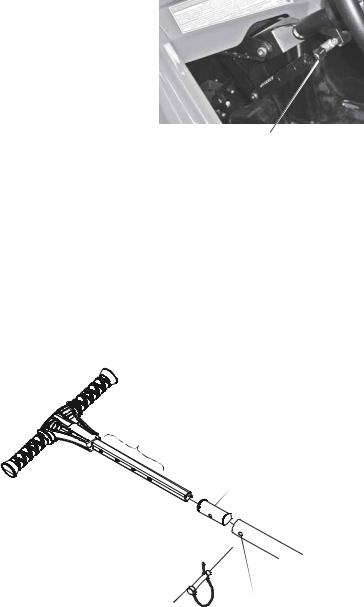
FEATURES AND CONTROLS
Steering Wheel
The steering wheel can be tilted upward or downward for rider preference.
Lift and hold the steering |
|
wheel adjustment lever |
|
while moving the steering |
|
wheel upward or down- |
|
ward. Release the lever |
|
when the steering wheel is |
Adjustment Lever |
at the desired position. |
Passenger Hand Hold
Always adjust the hand hold to a comfortable position for your frontseat passenger before operating. Make sure the adjustment pin and retainer are securely installed after making adjustments.
1.Remove the retainer from the end of the adjustment pin.
2.Remove the pin from the post.
3.Slide the post inward or outward to the desired position.
4.Reinstall the pin through the post mounting hole, adapter bushing hole, both post adjustment holes and lastly through the remaining bushing hole and post mounting hole.
5.Reinstall the retainer to the pin.
|
A |
|
|
|
|
|
|
|
|
||
P |
|
d |
|
|
|
|
|
|
|
|
|
|
|
j |
|
|
|
|
|
|
|||
o |
|
|
u |
|
|
|
|
|
|||
|
s |
|
|
|
s |
|
|
|
|
||
|
i |
|
|
t |
|
|
|
||||
|
|
|
|
|
|
m |
|
|
|||
|
|
i |
|
|
|
|
|
|
|
|
|
|
|
|
t |
|
|
|
|
|
e |
|
|
|
|
|
o |
|
|
|
|
||||
|
|
|
|
|
n |
H |
|
n |
|||
|
|
|
|
|
|
|
|
|
t |
||
|
|
|
|
|
|
|
|
o |
|
||
|
|
|
|
|
|
|
|
|
|
l |
|
|
|
|
|
|
|
|
|
|
|
e |
|
|
|
|
|
|
|
|
|
|
|
|
s |
Adapter
Bushing
Pin
Retainer

Adjustment |
Post Mounting |
|
Holes |
||
Pin |
||
|
28
